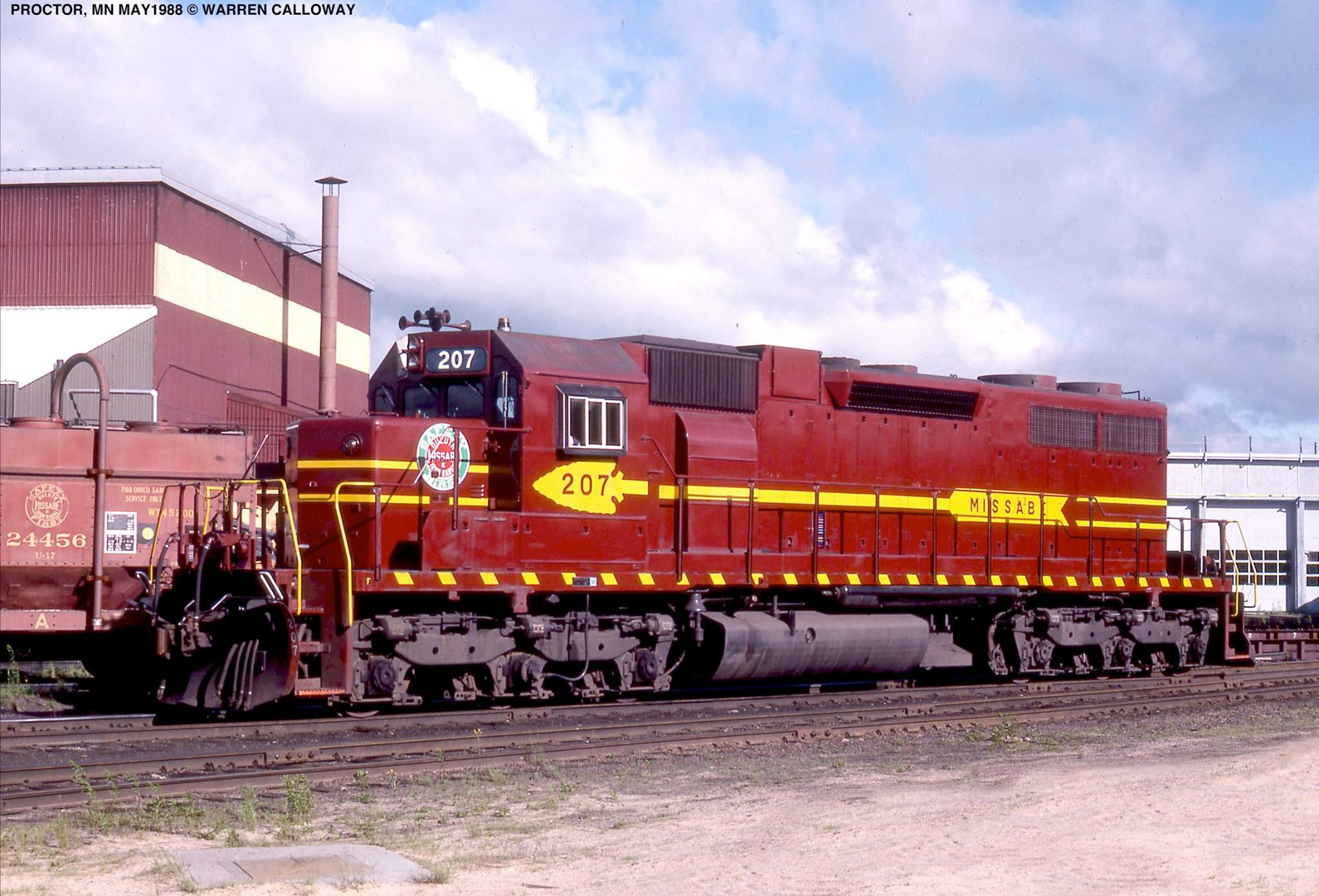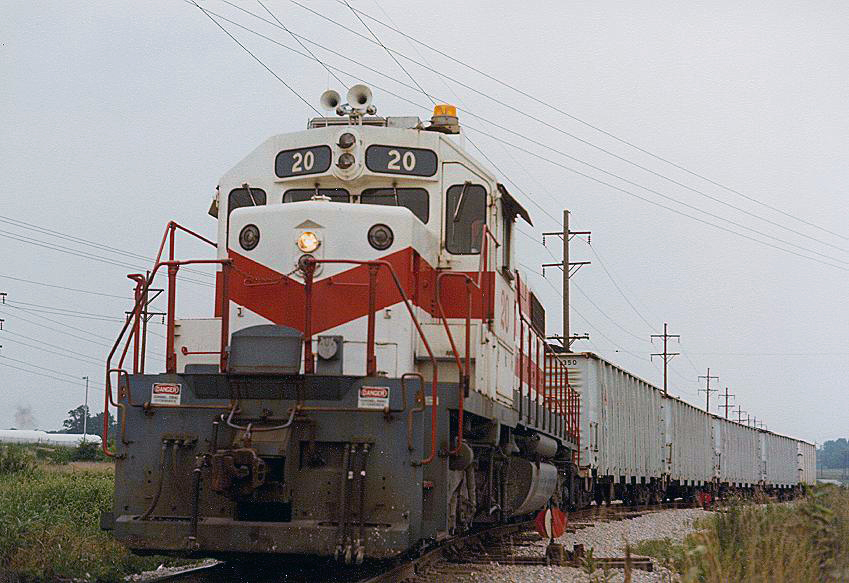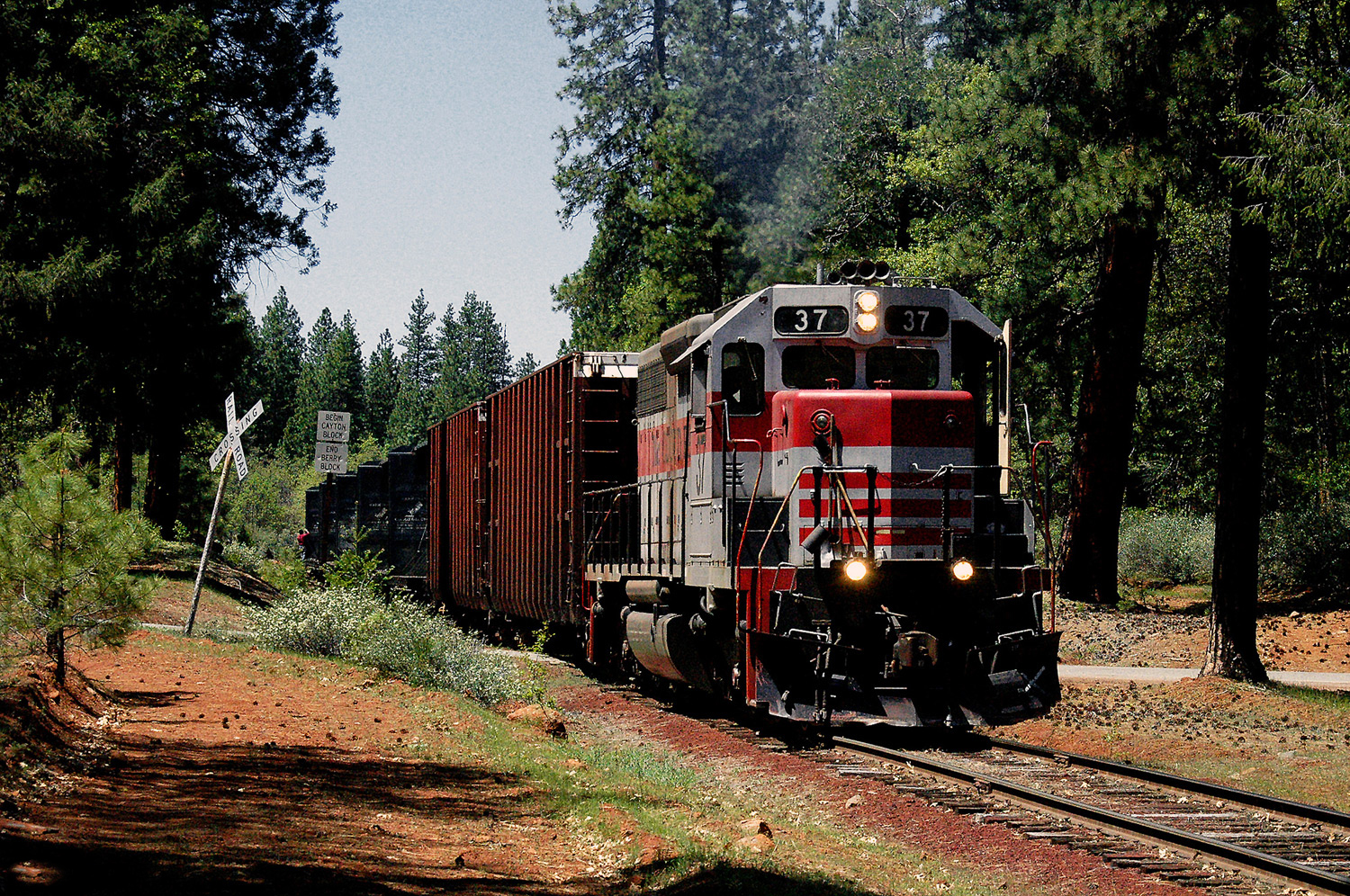EMD "SD38" and "SD38-2" Locomotives: Data Sheet, Specs, Roster
Last revised: December 16, 2024
By: Adam Burns
The SD38 series included the original model and later variants, the SD38AC and SD38-2, as well as the 12-cylinder SD39. These units were equipped with Electro-Motive's latest 645 prime mover.
What was essentially a C-C version of the builder's popular four-axle GP38, the SD38 was not a big seller due its modest horsepower rating. By contrast, the SD40 and SD45 - models which offered 3,000 and 3,600 horsepower respectively - sold more than 1,200 examples each.
Most Class 1s had passed on the SD38 and, as Greg McDonnell notes in his book, "Locomotives: The Modern Diesel & Electric Reference," most buyers were ore and coal haulers which utilized the units in heavy drag service.
Photos
 Duluth, Missabe & Iron Range SD38AC #207 is seen here in Proctor, Minnesota during May of 1988. Warren Calloway photo.
Duluth, Missabe & Iron Range SD38AC #207 is seen here in Proctor, Minnesota during May of 1988. Warren Calloway photo.History
The SD38 was the six-axle variant of EMD's mid-powered locomotive line sporting the builder's then-new model 645 prime mover.
In his book, "EMD Locomotives," author Brian Solomon notes that in late 1965 EMD advertised nine new models equipped with its latest engine offered in a range of horsepower ratings, sizes, and wheel arrangements.
The SD38 began production in May, 1967, powered by EMD's 16-cylinder, model 645E3 power plant. Unfortunately, while the company correctly read the mid-powered market in four-axle models - selling more than 3,000 examples of the GP38 series - the industry was largely disinterested in such six-axle designs.
Buyers were largely only those in need of greater footing in drag service. These included the Bessemer & Lake Erie; Detroit, Toledo & Ironton; McCloud River Railroad; Elgin, Joliet & Eastern; and Penn Central (its 35 was the most by a single customer).
SD38-2
In 1972, EMD released its "Dash 2" line, which included the SD38-2. In his book, "Locomotives: The Modern Diesel & Electric Reference," author Greg McDonnell notes EMD listed 40 refinements to the Dash 2 line although nearly all of these were internal, aimed at improving locomotive efficiency and operation.
Dash 2s generally saw higher sales than their standard counterparts. However, the SD38-2 sold only a disappointing 90 examples to Bessemer & Lake Erie; Yankeetown Dock; Reserve Mining; Penn Central; Southern Pacific; Chicago & Illinois Midland; Chicago & North Western; Frisco; Southern Pacific; Louisville & Nashville; U.S. Steel; and Duluth, Missabe & Iron Range.
 The Yankeetown Dock Corporation acquired a few SD38-2's to handle coal tonnage. Here, #20 readies to take empties back to the mines at Yankeetown, Indiana on July 26, 1980. Doug Kroll photo.
The Yankeetown Dock Corporation acquired a few SD38-2's to handle coal tonnage. Here, #20 readies to take empties back to the mines at Yankeetown, Indiana on July 26, 1980. Doug Kroll photo.The model looked almost identical to the SD40-2 with its long front and aft "porches" which gave the locomotive a length of over 68-feet, three feet longer than the SD38. Like its GP38 cousin, the SD38 differs from other models by its two large, rear radiator fans instead of three.
Data Sheet and Specifications
| Entered Production | 5/1967 (Bessemer & Lake Erie #861-863) |
| Years Produced (SD38) | 5/1967 - 7/1971 |
| Years Produced (SD38-2) | 11/1972 - 6/1979 |
| Years Produced (SD38AC) | 6/1971 - 7/1971 |
| Years Produced (SD39) | 8/1968 - 4/1970 |
| Years Produced (SDL39) | 3/1969 - 11/1972 |
| Engine | 645E3 |
| Engine Builder | GM |
| Horsepower | 2000 |
| Horsepower (SD39) | 2300 |
| RPM | 800 |
| Cylinders | 16 |
| Cylinders (SD39) | 12 |
| Length | 65' 8" |
| Length (SD39) | 65' 9" |
| Length (SDP38, SD38-2) | 68' 10" |
| Height (Top Of Rail To Top Of Cab) | 15' 5 ½" |
| Width | 10' 4" |
| Weight | 360,000 Lbs |
| Weight (SDL39) | 250,000 Lbs |
| Fuel Capacity | 3200 Gallons |
| Fuel Capacity (SDL39) | 1700 Gallons |
| Air Compressor | Gardner-Denver |
| Air Compressor Model | WBO |
| Air Brake Manufacturer | Westinghouse |
| Air Brake Schedule | 26L |
| Trucks | C-C |
| Truck Type | HT-C |
| Truck Wheelbase | 13' 7" |
| Wheel Size | 40" |
| Traction Motors | D77 (6), GM |
| Primary Generator | D32, GM |
| Primary Generator (SD38-2) | AR10, GM |
| Auxiliary Generator | Delco (A8102) |
| Steam Generator (SDP38) | Vapor-Clarkson (model AR4125) |
| Alternator | D14 |
| MU (Multiple-Unit) | Yes |
| Dynamic Brakes | Yes |
| Gear Ratio | 59:15 |
| Tractive Effort (Starting) | 90,000 Lbs at 25% |
| Tractive Effort (Starting) | 82,800 Lbs at 25% (SDL39) |
| Tractive Effort (Continuous) | 82,100 Lbs at 6.6 mph |
| Tractive Effort (Continuous) | 82,100 Lbs at 8 mph |
| Top Speed | 95 mph |
Production Roster
SD38
Total Built = 108
| Owner | Road Number(s) | Serial Number(s) | Order Number | Completion Date |
|---|---|---|---|---|
| Bessemer & Lake Erie | 861-863 | 33053-33055 | 7986 | 5/1967 |
| Detroit, Toledo & Ironton | 250-252 | 34863-34865 | 7161 | 7/1969-8/1969 |
| McCloud River | 36-38 | 34880-34882 | 7167 | 5/1969 |
| Elgin, Joliet & Eastern | 650-654 | 36141-36145 | 7243 | 1/1970-2/1970 |
| Elgin, Joliet & Eastern | 655 | 36163 | 7243 | 2/1970 |
| Penn Central | 6925-6959 | 36406-36440 | 7264 | 5/1970 |
| Detroit, Toledo & Ironton | 253-254 | 36872-36873 | 7330 | 7/1971 |
Export
| Owner | Road Number(s) | Serial Number(s) | Order Number(s) | Completion Date |
|---|---|---|---|---|
| Kaiser Bauxite (Jamaica) | 5101 | 31609 | 710498 | 6/1966 |
| Central Railway of Brazil | 3601-3645 | 32183-32227 | 710636-710680 | 2/1967-4/1967 |
| Kaiser Bauxite (Jamaica) | 5102 | 32859 | 710769 | 2/1967 |
| Orinoco Mining Company (Venezuela) | 1021-1023 | 32964-32966 | 710832-710834 | 4/1967 |
| Orinoco Mining Company (Venezuela) | 1024-1027 | 36830-36833 | 711667-711670 | 8/1970 |
| Kaiser Bauxite (Jamaica) | 5103 | 37077 | 711818 | 6/1971 |
| Kaiser Bauxite (Jamaica) | 5104 | 38479 | 712147 | 8/1971 |
SD38-2
Total Built = 90
| Owner | Road Number(s) | Serial Number(s) | Completion Date |
|---|---|---|---|
| Yankeetown Dock Corporation | 20-21 | 5795-1, 5795-2 | 11/1972 |
| Bessemer & Lake Erie | 870-878 | 72677-1 thru 72677-9 | 3/1973-5/1973 |
| Southern Pacific | 2971-2976 | 72681-1 thru 72681-6 | 4/1973 |
| Elgin, Joliet & Eastern | 656-659 | 73654-1 thru 73654-4 | 1/1974 |
| Chicago & Illinois Midland | 70-75 | 74605-1/6 | 5/1974 |
| Bessemer & Lake Erie | 879 | 74612-1 | 2/1974 |
| McCloud River Railroad | 39 | 74623-1 | 8/1974 |
| Duluth, Missabe & Iron Range | 209-213 | 74649-1 thru 74649-5 | 3/1975 |
| Bessemer & Lake Erie | 890-891 | 74677-1/2 | 4/1975 |
| Louisville & Nashville | 4500-4504 | 74679-1 thru 74679-5 | 1/1975 |
| Elgin, Joliet & Eastern | 660-664 | 75602-1 thru 75602-5 | 1/1975 |
| Chicago & North Western | 6650-6659 | 75618-1 thru 75618-10 | 1/1975 |
| Elgin, Joliet & Eastern | 665-668 | 756067-1 thru 756067-4 | 11/1975 |
| Bessemer & Lake Erie | 892 | 756069-1 | 3/1976 |
| U.S. Steel (Cumberland Mine) | 1 | 756078-1 | 12/1975 |
| Yankeetown Dock Corporation | 22 | 776049-1 | 12/1978 |
| Reserve Mining Company | 1237-1245 | 786142-1 thru 786142-9 | 10/1978 |
| St. Louis-San Francisco Railway (Frisco) | 296-297 | 786187-1, 786187-2 | 6/1979 |
| St. Louis-San Francisco Railway (Frisco) | 298-299 | 786199-1, 786199-2 | 6/1979 |
Export
| Owner | Road Number(s) | Serial Number(s) | Order Number | Completion Date |
|---|---|---|---|---|
| B.C. Hydro & Power Authority (Canada) | 382-383 | 71606-1, 71606-2 | C348 (GMDD) | 12/1972 |
| B.C. Hydro & Power Authority (Canada) | 384 | 74614-1 | C367 (GMDD) | 8/1974 |
| Orinoco Mining Company (Venezuela) | 1028-1029 | 713290-713291 | 713290-713291 | 10/1974 |
| Orinoco Mining Company (Venezuela) | 1030-1032 | 748031-1 thru 748031-3 | 748031 | 6/1976 |
| Jari Railway (Brazil) | 10-11 | 778022-1, 778022-2 | 778022 | 6/1978 |
SD38AC
Total Built = 15
| Owner | Road Number(s) | Serial Number(s) | Order Number | Completion Date |
|---|---|---|---|---|
| Duluth, Missabe & Iron Range | 201-208 | 37069-37076 | 06/71 (5767) | |
| Bessemer & Lake Erie | 864-869 | 37703-37708 | 07/71 (7327) | |
| B.C. Hydro & Power Authority (Canada) | 381 | 37816 | C340 (GMDD) | 10/1971 |
SD39
Total Built = 54
| Owner | Road Number(s) | Quantity | Date Built | |
|---|---|---|---|---|
| Southern Pacific | 5300-5317 | 33998-34015 | 7110 | 8/1968-10/1968 |
| Minneapolis, Northfield & Southern | 40-41 | 34127-34128 | 7119 | 10/1968 |
| Illinois Terminal | 2301-2306 | 34883-34888 | 7168 | 5/1969-6/1969 |
| Santa Fe | 4000-4011 | 35020-35031 | 7176 | 5/1969 |
| Santa Fe | 4012-4019 | 35032-35039 | 7178 | 6/1969 |
| Southern Pacific | 5318-5325 | 35815-35822 | 7219 | 4/1970 |
SDL39
Total Built = 10
| Owner | Road Numbers | Serial Numbers | Order Number | Completion Date |
|---|---|---|---|---|
| Milwaukee Road | 581-585 | 34272-34276 | 7135 | 3/1969 |
| Milwaukee Road | 586-590 | 7345-1 thru 7345-5 | 72648 | 11/1972 |
Export Variants
SDP38
Total Built = 40
| Owner | Road Numbers | Serial Numbers | Order Numbers | Completion Date |
|---|---|---|---|---|
| Korean National Railroad | 6351-6390 | 32914-32953 | 710792-710831 | 5/1967-7/1967 |
SD38-2TC
Total Built = 8
| Owner | Road Numbers | Serial Numbers | Order Number | Completion Date |
|---|---|---|---|---|
| Orinoco Mining Company (Venezuela) | 1041-1048 | 928793-1 thru 928793-8 | 928793 | 6/1994 |
SDL38
Total Built = 6
| Owner | Road Numbers | Serial Numbers | Order Number | Completion Date |
|---|---|---|---|---|
| Saudi Government Railway | 2030-2035 | 20148061-1 thru 20148061-6 | 20148061 | 7/2016-8/2016 |
SDL38-2
Total Built = 6
| Owner | Road Numbers | Serial Numbers | Order Number | Completion Date |
|---|---|---|---|---|
| Saudi Government Railway | 2004-2009 | 778050-1 thru 778050-6 | 778050 | 8/1978 |
 McCloud River Railroad SD38 #37 switches customers at Cayton, California on May 11, 2006. This was one of the three the road purchased in 1969. The historic short line has since closed. Drew Jacksich photo.
McCloud River Railroad SD38 #37 switches customers at Cayton, California on May 11, 2006. This was one of the three the road purchased in 1969. The historic short line has since closed. Drew Jacksich photo.SD38AC
The SD38AC was all but identical to the original except for its AR10 alternator in place of the standard model D32 generator. As horsepower ratings increased, the size of DC generators likewise increased.
With space inside an engine hood limited, the use of a more efficient alternator solved this problem. Just 15 of these units were sold; six to the B&LE, eight to the Missabe, and one to BC Hydro & Hydro Power Authority.
SD39/SDL39
The SD39/SDL39 was part of the SD38 catalog by way of its turbocharged, 12-cylinder 645E3 prime mover. The more fuel efficient model could produce an additional 300 horsepower.
As Louis Marre notes in his book, "Diesel Locomotives: The First 50 Years," most railroads avoided mid-powered, turbocharged models due to their increased maintenance. The SD39 can be easily distinguished by its single, rectangular turbocharger stack directly behind the central air intake. Ultimately, only 54 were sold.
The SDL39 was a special variant requested by the Milwaukee Road. The "L" denoted "lightweight," as its shorter frame and fuel tank made the locomotive ideal to handle the light rail, rickety bridges, and generally poorly maintained secondary branch lines found throughout the railroad's Midwestern network. Just 10 were built between 1969-1972.
Sources
- Foster, Gerald. A Field Guide To Trains. New York: Houghton Mifflin, 1996.
- Marre, Louis A. Diesel Locomotives: The First 50 Years, A Guide To Diesels Built Before 1972. Milwaukee: Kalmbach Publishing Company, 1995.
- Pinkepank, Jerry A. Diesel Spotter's Guide. Milwaukee: Kalmbach Publishing Company, 1967.
- Schafer, Mike. Vintage Diesel Locomotives. Osceola: MBI Publishing, 1998.
- Solomon, Brian. EMD Locomotives. Minneapolis: MBI Publishing Company, 2006.
- Solomon, Brian. GE and EMD Locomotives: The Illustrated History. Minneapolis: Voyageur Press, 2014.
Contents
Recent Articles
-
Missouri's 'Wine Tasting' Train Rides
Dec 12, 25 04:13 PM
The fusion of scenic vistas, historical charm, and exquisite wines is beautifully encapsulated in Missouri's wine tasting train experiences. -
Minnesota's 'Wine Tasting' Train Rides
Dec 12, 25 04:07 PM
This article takes you on a journey through Minnesota's wine tasting trains, offering a unique perspective on this novel adventure. -
Texas - Murder Mystery - Dinner Train Rides
Dec 12, 25 01:06 PM
Here’s a comprehensive look into the world of murder mystery dinner trains in Texas.



